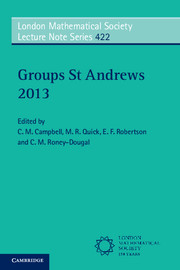Book contents
- Frontmatter
- Contents
- INTRODUCTION
- Approximate subgroups and super-strong approximation
- Width questions for finite simple groups
- Profinite properties of discrete groups
- GL(n, Z), Out(Fn) and everything in between: automorphism groups of RAAGs
- Permutation groups and transformation semigroups: results and problems
- New progress on factorized groups and subgroup permutability
- A survey on the normalizer problem for integral group rings
- A survey on Clifford-Fischer theory
- A generalisation on the solvability of finite groups with three class sizes for normal subgroups
- Automorphism groups of non-orientable Riemann surfaces
- What are the C2-groups?
- Resurrecting Wells’ exact sequence and Buckley's group action
- Recent work on Beauville surfaces, structures and groups
- Something for nothing: some consequences of the solution of the Tarski problems
- The groups of projectivities in finite planes
- On the relation gap and relation lifting problem
- Some results on products of finite subsets in groups
- Formal languages and group theory
- On the Castelnuovo-Mumford regularity of the cohomology of fusion systems and of the Hochschild cohomology of block algebras
- Recent advances on torsion subgroups of integral group rings
- On finite groups with small prime spectrum
- Solvability criteria for finite loops and groups
- The rational subset membership problem for groups: a survey
- A survey of Milnor laws
- Capable p-groups
- On the normal structure of a finite group with restrictions on the maximal subgroups
- Certain monomial characters and their normal constituents
- Recognition of finite quasi-simple groups by the degrees of their irreducible representations
- Generalized Baumslag-Solitar groups: a survey of recent progress
- Zeta functions of groups and rings – recent developments
GL(n, Z), Out(Fn) and everything in between: automorphism groups of RAAGs
Published online by Cambridge University Press: 05 September 2015
- Frontmatter
- Contents
- INTRODUCTION
- Approximate subgroups and super-strong approximation
- Width questions for finite simple groups
- Profinite properties of discrete groups
- GL(n, Z), Out(Fn) and everything in between: automorphism groups of RAAGs
- Permutation groups and transformation semigroups: results and problems
- New progress on factorized groups and subgroup permutability
- A survey on the normalizer problem for integral group rings
- A survey on Clifford-Fischer theory
- A generalisation on the solvability of finite groups with three class sizes for normal subgroups
- Automorphism groups of non-orientable Riemann surfaces
- What are the C2-groups?
- Resurrecting Wells’ exact sequence and Buckley's group action
- Recent work on Beauville surfaces, structures and groups
- Something for nothing: some consequences of the solution of the Tarski problems
- The groups of projectivities in finite planes
- On the relation gap and relation lifting problem
- Some results on products of finite subsets in groups
- Formal languages and group theory
- On the Castelnuovo-Mumford regularity of the cohomology of fusion systems and of the Hochschild cohomology of block algebras
- Recent advances on torsion subgroups of integral group rings
- On finite groups with small prime spectrum
- Solvability criteria for finite loops and groups
- The rational subset membership problem for groups: a survey
- A survey of Milnor laws
- Capable p-groups
- On the normal structure of a finite group with restrictions on the maximal subgroups
- Certain monomial characters and their normal constituents
- Recognition of finite quasi-simple groups by the degrees of their irreducible representations
- Generalized Baumslag-Solitar groups: a survey of recent progress
- Zeta functions of groups and rings – recent developments
Summary
Abstract
A right-angled Artin group (RAAG) is a group given by a finite presentation in which the only relations are that some of the generators commute. Free groups and free abelian groups are the extreme examples of RAAGs. Their automorphism groups GL(n, Z) and Out(Fn) are complicated and fascinating groups which have been extensively studied. In these lectures I will explain how to use what we know about GL(n, Z) and Out(Fn) to study the structure of the (outer) automorphism group of a general RAAG. This will involve both inductive local-to-global methods and the construction of contractible spaces on which these automorphism groups act properly. For the automorphism group of a general RAAG the space we construct is a hybrid of the classical symmetric space on which GL(n, Z) acts and Outer space with its action of Out(Fn).
Introduction
In these lectures we will study the group of (outer) automorphism groups of a right-angled Artin group. Most of the material can be found in the papers [5, 7, 8, 6] which are all joint with Ruth Charney, some with additional authors. I will first go over some basic facts about right-angled Artin groups, then introduce inductive algebraic methods for studying these groups, then turn to more recent work on geometric methods. I will concentrate on describing and motivating the constructions but avoid proofs, however I will give explicit references to sources where the interested reader can find detailed proofs.
The Groups St Andrews conference was run seamlessly by Colin Campbell, Edmund Robertson, Max Neunhoeffer, Colva Roney-Dougal and Martyn Quick, and I would like to thank them all warmly for inviting me to give these lectures.
Lecture 1
Definition of a RAAG
A right-angled Artin group, or RAAG for short, is a finitely-presented group whose relators (if any) are all simple commutators of generators. The extreme examples of RAAGs are free groups (with no relators), and free abelian groups (with all possible commutators of generators as relators). A RAAG is often specified by drawing a graph Γ with one vertex for each generator and one edge between two vertices if the corresponding generators commute (see Figure 1). Note that Γ is a simplicial complex, i.e., it has no loops or multiple edges.
- Type
- Chapter
- Information
- Groups St Andrews 2013 , pp. 105 - 127Publisher: Cambridge University PressPrint publication year: 2015
- 6
- Cited by



